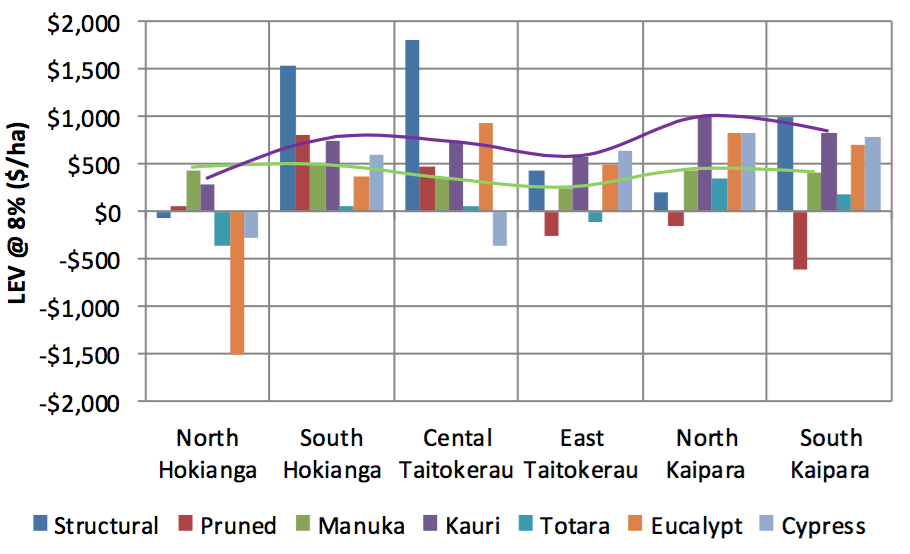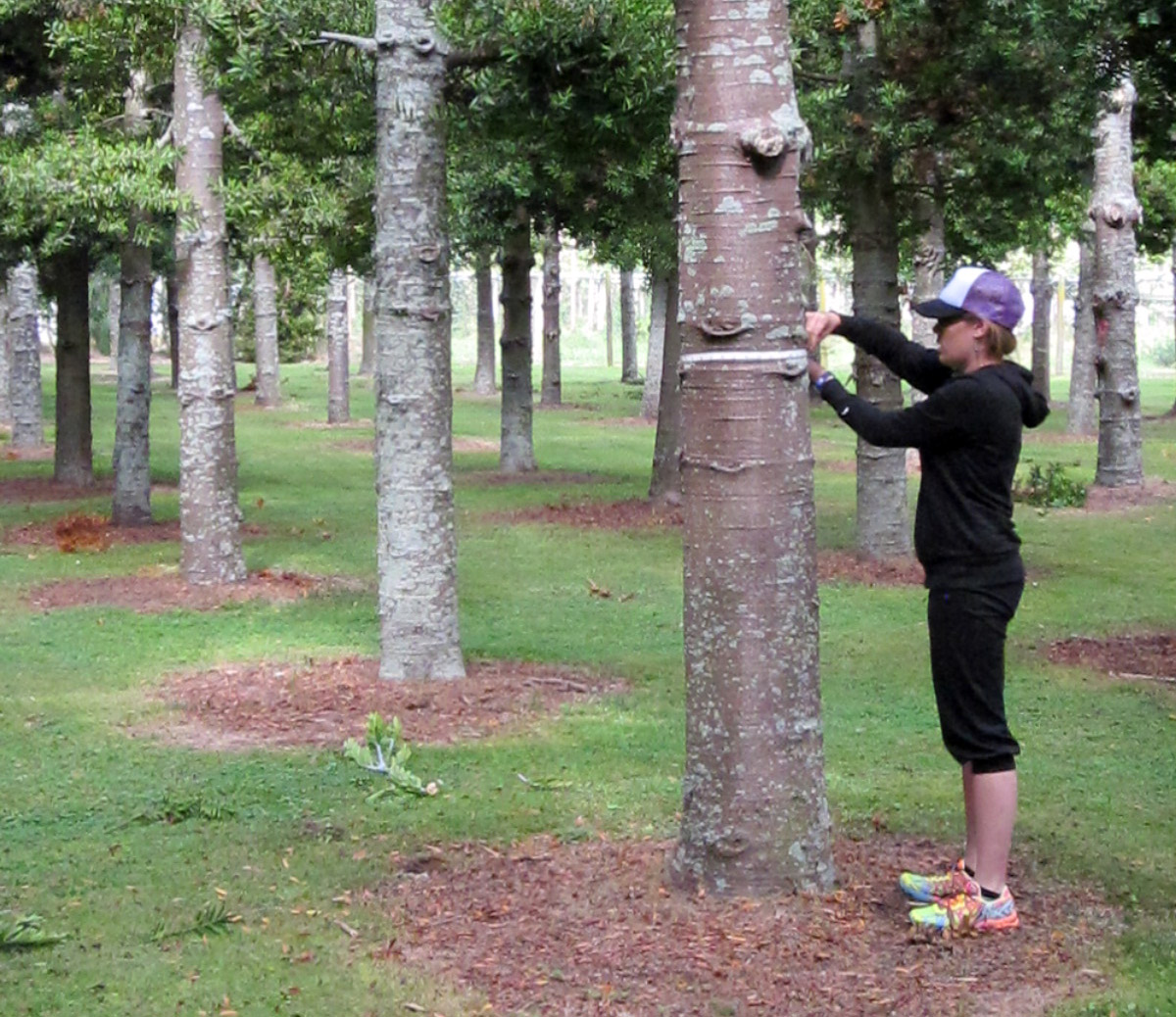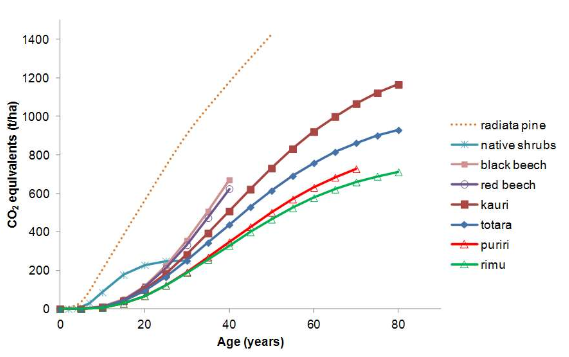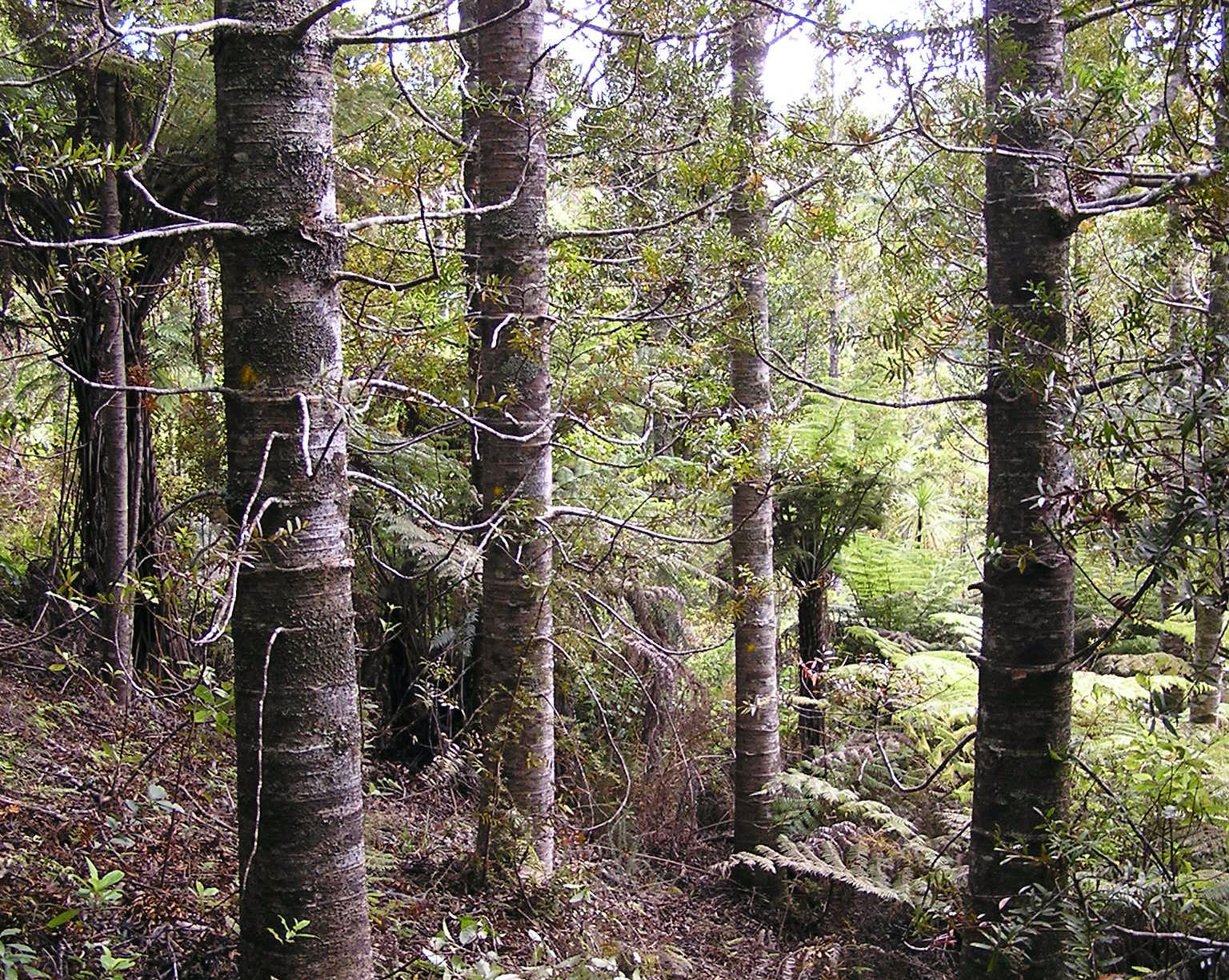Last month I called for a bloody big new forest in New Zealand: 1.3 million hectares by my reckon. Could be more, could be less – but this is the right ballpark for a meaningful reduction to our net greenhouse gas emissions.
The report, Our Forest Future, prompted plenty of discussion, but one issue stood out: a lot of New Zealanders have had a gutsful of Pinus radiata.
I’ll save the pros and cons of radiata for another day. Here I’ll discuss some alternatives; specifically, the potential for native trees as commercial forests. Because by bringing new native forest into the mix – for commercial planting as well as conservation planting – we can plan for a forest future that New Zealanders might actually want.
Common opinion will tell you that natives grow too slowly to be profitable. But the reality is more complicated.
“It’s like a craft beer versus a Tui beer,” says forester Clayton Wallwork. “[Native forest] is more expensive to establish, but you’re going to get a higher-quality timber, a higher-quality product, as a result. You’re also going to have a whole lot of other benefits – to the community, to the environment.”
Wallwork is involved in a project called “Our Forests, Our Future”, led by Tane’s Tree Trust. The intention is to get a better handle on the economic potential of native forest, not only for timber but also for environmental benefits.
The project is ongoing, focused on demonstration forests of beech in the South Island and totara in Northland. Trials won’t be complete until 2018 – but early signs are positive. They’re looking at the processing, the timber grading, the pricing; and Wallwork says of the totara that “it’s already a lot higher than what you’d get for radiata.”
You might wonder: how can anyone do field trials on trees when they take so long to grow? Won’t it take decades to get results?
The Northland Totara Working Group, established in 2005, looks at totara that self-regenerated on farmland. As long as landowners left the seedlings to grow to maturity, these decades-old trees can serve as approximations for how totara would grow if planted deliberately. Since 2007, the Working Group has pruned and thinned these forest plots, to see how they respond to best forestry practice.
Dr David Bergin, who also works on the project, is an expert on totara, a wood prized for its durability and workability. He’d like to see a more nuanced national forestry, where we’re “matching the appropriate species to the appropriate site… blending in a diverse multi-use forestry with existing land uses.”
Our commercial forests are currently 90 per cent Pinus radiata. Bergin says: “With radiata, you’re dealing with a high volume, low value, commodity; so, you’ve got to grow that on an industrial scale.” He’s worked alongside Māori landowners in Northland managing large pine plantations, mostly shipped to China as cheap unprocessed logs. He says “they’re getting a peppercorn rental; they’re on steep difficult country with poor soils; they’re hardly making anything out of it after trucking costs – so it’s marginal even for radiata.” He says there’s a real hunger for alternatives.
Forestry research centre Scion is also engaged in indigenous forest research. One recent study found that kauri, along with mānuka, made positive economic returns in six areas around Northland (see graph below). Indeed, in four of the six areas, the investment case for kauri was superior to, or comparable to, Pinus radiata, both pruned and structural-grade.
The study estimated the land expectation values (LEVs) for different kinds of forest, then calculated incomes by factoring in costs of planting, harvesting, transport, and annuity. The areas where radiata performed best—South Hokianga, Central Taitokerau, and South Kaipara—were all areas where markets were closest and transport costs low. But, averaging across them, the income for kauri was estimated to be 4.7 times higher than structural-grade radiata pine over a 60-year period.

Land expectation values (8% discount rate) of Pinus radiata (prune and structural grade) alongside native species. Source: Scion, 2014.
So, if native trees aren’t such a bad investment, why aren’t we growing them?
For decades, native forestry has been held back because reliable information is all-too-rare and unreliable information is all-too-common.
One of the researchers on the Scion study, Greg Steward, tells me: “It’s about getting us away from that anecdotal information that’s been promulgated around the countryside since the days of Kirk and Cheeseman.”
When Steward studied kauri for his Masters degree at University of Canterbury, he found far higher rates of productivity than anyone expected, occasionally getting close to Pinus radiata on optimal sites. Since then he’s helped to develop the Kauri Calculator, an online tool for landowners which predicts future production and income for kauri.
People are taking a second look at natives, he says, “because now we’ve got data. You can deny anecdotes until the cows come home, but you can’t deny data.”
Misinformation goes back as far as early European settlement. Under the Waste Lands Act of 1854, native forests were defined as precisely that – as “waste lands” – and treated accordingly. The common view was that one blade of grass was worth more than two trees.
Not everyone went along with this. By the late 1800s, says Steward, “various folk were starting to question how we were managing our forests and our native timber resources.” At the time, we were not only cutting down ancient forests to export timber overseas, we were also starting to import foreign timber to meet local demand. Yet New Zealand chose to undertake large-scale planting of exotic pine throughout the 1920s to boost domestic supply. In 1919, forester Sir David Hutchins observed: “for reasons which have never been satisfactorily explained, it has been thought to replace the valuable native forest of New Zealand by artificial plantations of exotics – a quite unusual proceeding in forestry”.
Some early field trials for natives – although showing promise – were sidelined in this rush to plant exotics. Later trials were conducted on public land, often at high altitude or on land recently clear-felled. Unsurprisingly, these sub-optimal sites produced sub-optimal results. Some historical data, Steward says, no one knows its origins, nor therefore its reliability.

A 17-year-old kauri stand near Tauranga with stems of 34 centimetres diameter at breast height. Recent density analysis of this stand indicates growth rate is not affecting wood density. Source: Steward et al., 2014. Republished with permission of Greg Steward.
Meanwhile, Pinus radiata has benefited from decades of government and industry research. Landowners can easily estimate their return-on-investment for radiata, as well as carbon sequestration rates. Selective breeding has also made it a “super-species”, fast growing and resilient to disease. While there’s no reason that native trees couldn’t also be optimised through selective breeding, that work hasn’t yet been done.
To put it bluntly, New Zealand forestry is suffering from a bad case of “path dependency”. In other words, our decisions in the present are constrained by decisions from the past. The historical dominance of Pinus radiata makes its continued dominance a foregone conclusion.
It’s this hurdle that Wallwork, Bergin and others hope to overcome with the “Our Forest, Our Future” project.
“There’s knowledge out there,” says Wallwork, “but no one can see a demonstration forest that’s been done, that has the books open to show what the potential revenues are.”
Bergin adds: “This project is about getting blocks of reasonable scale, demonstrating best practice, and dispelling those misperceptions out there.”
It’s not that Bergin is dead-set against radiata: “It seems to occupy a gap in our flora that we don’t have an equivalent to. It’s very plastic, grows on a range of sites, it’s very forgiving, it grows really fast initially.”
But he wants to see “multi-species, multi-age, multi-purpose forestry as a mosaic across a landscape, for which I think native forestry has excellent potential to blend in with those other land uses.” He reckons that once we go down this route, “this is where the real foresters come out of the woodwork – if you know what I mean – where they have to understand forest ecology, not as a crop but as an ecosystem.”
But that transition will require effort. To break the path-dependency of Pinus radiata, there needs to be more research, which means more research funding. It’ll also require market development, particularly educating New Zealanders to choose sustainably grown native timbers, rather than import foreign timbers which aren’t always sustainably harvested. It’ll require industrial-scale nurseries and economies of scale to bring down the price of establishment. Finally, where local rules prohibit the felling of all native trees, even those that were planted deliberately, we’ll need to find regulatory solutions that enable sustainable native forestry without endangering conservation efforts.
So what about climate change?
Evidence shows that natives, on average, don’t grow as quickly as Pinus radiata, and so sequester carbon more slowly.
Granted, there’s room to improve the growth rates of natives through selective breeding. There’s also room to be smarter about which trees go where: the right native tree on the right site with the right aftercare will likely defy many people’s expectations. Wallwork tells me that mānuka on the East Coast can compete with radiata in terms of sequestration. But this will likely only narrow the gap between the early growth rates of natives and exotics like radiata and eucalyptus, not close the gap entirely.

Predicted carbon sequestration rates on average sites. Source: Tāne’s Tree Trust, 2014.
Yet there are other things to consider.
A lot of what forests sequester isn’t in the wood, but in the biomass below the ground or on the forest floor. Kauri forest has one of the highest biomass carbon densities in the world. Although this below-ground biomass is excluded from conventional carbon accounting, from a climate perspective, it’s still carbon that’s locked out of the atmosphere.
Another issue is resilience. For example, kauri, once established, is highly resistant to drought, indeed even has a competitive advantage in dry conditions (that’s why kauri often clusters on ridgelines). It is also, like totara, a sturdy tree that isn’t susceptible to wind throw. So, if global warming means more droughts and more violent storms for New Zealand – which is what the Royal Society predicts – then there’s good reason to plan more diverse forests, rather than gamble on a monoculture that’s uniformly vulnerable to the same hazards.
There’s also questions over long-term strategy for permanent forests. Bergin notes that, although some exotics have a growth advantage in early decades, this diminishes over successive decades because the growth of radiata eventually plateaus at around fifty years. Once we’ve reached, say, one-hundred years, though, we’re talking about mature native and exotic forests that are storing comparable volumes of carbon. But the native forests may well be more sustainable over the long run, because of their intrinsic value and more diverse income opportunities. Wallwork notes that, when carbon forestry was first floated, all sorts of ridiculous plans were hatched for densely spaced forests of radiata, unthinned and unpruned, which would have aged into hazardous and unmanageable forests with little value beyond their stored carbon. Such forests, as you can imagine, would be first in line for land use conversion.
What are we to learn from this?
Our forest future doesn’t need to be a future of Pinus radiata alone. There are alternatives on the table. And that’s just as well, because as long as landowners have a choice over what they plant, then many landowners won’t want to plant radiata pine (at least not without handsome incentives). Given that the majority of land available for future forest is privately owned, climate policy needs to take seriously the preferences of people, whether its their aesthetic preferences, cultural values like kaitiakitanga, or concerns over biodiversity and wilding pines. A native tree in the ground will always sequester more carbon than a fast-growing exotic that never gets planted at all. This is why, in the Our Forest Future report, I called for a principle of “appropriate diversification”.
Fortunately, native trees are not only a feasible option, they’re sometimes the more profitable option, especially when landowners pick the right tree for the right site. That doesn’t mean we should only plant native trees with commercial purposes in mind. Native tree planting for conservation projects, for habitat restoration, for permanent forest sinks, and for riparian planting should be a part of the picture too – the bigger the better. But anyone who relies on their land as their principal source of income needs to make ends meet. Native planted forests – sensibly managed – can strike a balance between favourable economic returns and favourable environmental outcomes.
And if that isn’t green growth, then I don’t know what is.



Leave a comment